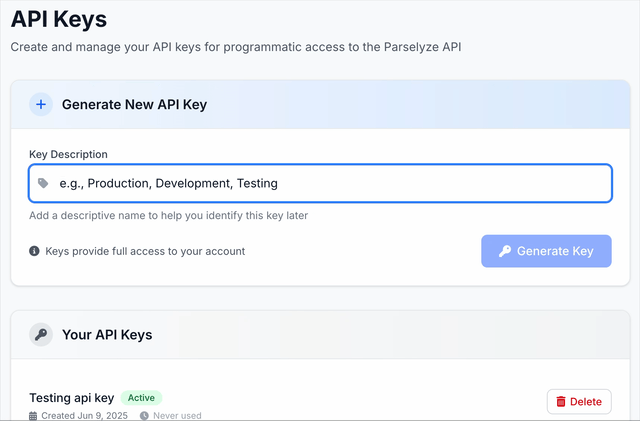Quick Start Guide
Get up and running with Parselyze in just a few minutes. This guide walks you through your first document analysis.
Prerequisites
- A Parselyze account
- An API key (generated from the web dashboard)
- A template ID (created from the web dashboard)
- A document to analyze (PDF, images, Zip)
Step 1: Create Your Template (Web Interface Only)
Templates via Web Interface
Templates must be created through the Parselyze web dashboard. You cannot create templates via API.
See Template Creation Tutorial.
Template Testing
Premium users can test their templates without consuming quota using the template testing feature. Learn more in our Template Testing Guide.
Step 2: Generate API Key (Web Interface Only)
- Log in to your Parselyze dashboard
- Navigate to "Account" > "API Keys"
- Provide a description
- Click "Generate Key"
- Copy and securely store the generated key

More informations: Api key documentation.
Step 3: Analyze Your First Document
Now let's analyze a document using your template:
curl -X POST https://api.parselyze.com/documents/parse \
-H "x-api-key: YOUR_API_KEY" \
-F "files=@invoice.pdf" \
-F "templateId=YOUR_TEMPLATE_ID"
Expected Response
{
"result": {
"invoice": {
"number": "INV-2025-001",
"date": "26/05/2025",
"total": 1250.75,
"vendor": "Acme Corporation"
}
},
"pageCount": 1,
"pageUsed": 1,
"pageRemaining": 999
}
Working with Different File Types
Single file
curl -X POST https://api.parselyze.com/documents/parse \
-H "x-api-key: YOUR_API_KEY" \
-F "files=@document.pdf" \
-F "templateId=YOUR_TEMPLATE_ID"
Multiple Files (Premium Only)
curl -X POST https://api.parselyze.com/documents/parse \
-H "x-api-key: YOUR_API_KEY" \
-F "files=@page1.jpg" \
-F "files=@page2.jpg" \
-F "templateId=YOUR_TEMPLATE_ID"
ZIP Archive (Premium Only)
curl -X POST https://api.parselyze.com/documents/parse \
-H "x-api-key: YOUR_API_KEY" \
-F "files=@documents.zip" \
-F "templateId=YOUR_TEMPLATE_ID"
Using JavaScript/Node.js
Here's a complete example using JavaScript:
import { Parselyze } from "parselyze";
const parselyze = new Parselyze("plz_xxxxxxxx...xxxxxx");
(async function () {
console.log("Start parsing document...");
const result = await parselyze.documents.parse({
files: ["./invoice.pdf"],
templateId: "<YOUR_TEMPLATE_ID>",
});
console.log("Parsing complete:", result);
})();
Using Python
import requests
import os
# You need to get template_id from your web dashboard
template_id = 'your-template-id-from-dashboard'
with open('invoice.pdf', 'rb') as file:
files = {'files': file}
data = {
'templateId': template_id
}
analyze_response = requests.post(
"https://api.parselyze.com/documents/parse",
headers={"x-api-key": os.getenv('PARSELYZE_API_KEY')},
files=files,
data=data
)
result = analyze_response.json()
print("Analysis result:", result)
Next Steps
- Template Creation: Learn how to create templates with our Template Creation Tutorial
- Advanced Analysis: Explore the Document Analysis guide for more features
- Handle Errors: Learn about Error Handling
- Authentication: Read more about Authentication
Common Issues
Template Not Working?
- Verify your template schema follows the correct format
- Test your template with a sample document first
- Check that field positions match your document layout
Getting 401 Errors?
- Ensure your API key is correct
- Check that you're including the
x-api-keyheader - Verify your API key hasn't expired
Files Not Processing?
- Confirm file format is supported (PDF, PNG, JPEG, ZIP)
- Check file size is under the limit (50MB)
- Ensure the file isn't corrupted
Need help? Check our Error Handling guide or contact support.